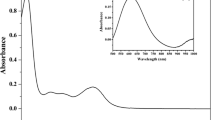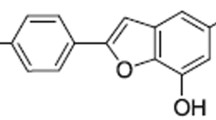Abstract
Purpose
Structure-activity studies were carried out with the model bioreductive alkylating agent benzoquinone mustard (BM) and its structural analogs. The specific objectives were: (1) to investigate the effects of functional group substitutions to the benzoquinone ring on DNA crosslink and strand break formation subsequent to reduction of the analogs by DT-diaphorase (DTD) in vitro, (2) to correlate DNA crosslink and strand break formation by the analogs with anaerobic reduction of the BM analogs by DTD and their redox cycling in vitro, and (3) to correlate DNA crosslink and strand break formation by the BM analogs with their cytotoxic effects in cancer cells.
Methods
DNA interstrand crosslink and single-strand break formation were assessed using agarose gel assays. To determine DNA interstrand crosslinks or single-strand breaks, linearized or supercoiled plasmid DNA, respectively, were incubated with purified human DTD and increasing concentrations of each BM analog. Subsequently, DNA was electrophoresed on an agarose gel and DNA crosslink and strand break formation were quantified using densitometry. The rates of reduction of the BM analogs by purified human DTD were measured in vitro under hypoxic conditions, and the redox cycling potential was determined under aerobic conditions using HPLC analysis. The cytotoxic activities of these agents in human tumor cell lines were measured by the MTT assay, with and without the DTD inhibitor, dicoumarol.
Results
BM analogs with electron-donating groups (MeBM, MBM, m-MeBM), electron-withdrawing groups (CBM, FBM), sterically bulky groups (PBM, m-PBM, m-TBM) and positional isomers (MeBM, m-MeBM, PBM, m-PBM) were synthesized. After reduction by DTD, the BM analogs produced a concentration-dependent increase in DNA crosslink and DNA strand break formation. The E10 (extent of DNA crosslink formation produced by 10 μM BM analog) for DNA crosslink formation displayed the rank order MeBM≈MBM>m-MeBM≈PBM≈BM>CBM>FBM>m-PBM≈m-TBM. For DNA strand break formation, the E10 values (extent of DNA strand break formation produced by 10 μM BM analog) displayed the rank order MeBM>MBM>m-MeBM>PBM>BM≈CBM>FBM>m-PBM≈m-TBM. Importantly, the cytotoxic activity of the BM analogs in SK-Mel-28 human melanoma cells correlated positively with the E10 values for DTD-mediated DNA crosslink formation (r s=0.87, P<0.05) and DNA strand break formation (r s=0.95, P<0.05). Similar correlations were observed in NCI-H661 human lung carcinoma cells. Furthermore, the D10 values (concentration of BM analog that decreased the surviving cell fraction to 0.1) for cytotoxic activity of the BM analogs correlated with the maximum levels of DNA crosslinks formed with each BM analog, with r s values of −0.85 (P<0.05) for the NCI-H661 cell line, and −0.81 (P<0.05) for the SK-MEL-28 cell line. The half-time of reduction (t1/2) of the BM analogs by DTD did not correlate with DNA crosslink formation, DNA strand break formation, or cytotoxic potency of the analogs.
Conclusions
Functional groups on the benzoquinone ring affect the ability of BM to produce DNA crosslinks and strand breaks following reduction by DTD. Electron-donating groups increased DNA damage, whereas electron-withdrawing groups and sterically bulky groups at the C6 position had no effect or decreased the ability of the compounds to produce DNA damage compared to BM. Moreover, both DNA crosslink and strand break formation appear to have an important impact on the cytotoxicity of the BM analogs. These results may have significance for optimal use of BM-based antitumor agents and for rationalization of the development of novel therapeutic compounds that require bioactivation by DTD.






Similar content being viewed by others
Abbreviations
- AZQ:
-
2,5-Diaziridinyl-3,6-bis(carboethoxyamino)-1,4-benzoquinone
- BM:
-
2-[Di(chloroethyl)amino]-1,4-benzoquinone
- CBM:
-
5-Chloro-2-[di(chloroethyl)amino]-1,4-benzoquinone
- DCPIP:
-
2,6-Di-chlorophenolindophenol
- DIC:
-
Dicoumarol
- DMF:
-
Dimethylformamide
- DTD:
-
NAD(P)H:quinone oxidoreductase
- DZQ:
-
3,6-Diaziridinyl-1,4-benzoquinone
- EO9:
-
3-Hydroxymethyl-5-aziridinyl-1-methyl-2-(H-indole-4,7-dione)-prop-2-en-1-ol
- FBM:
-
5-Fluoro-2-[di(chloroethyl)amino]-1,4-benzoquinone
- MBM:
-
5-Methoxy-2-[di(chloroethyl)amino]-1,4-benzoquinone
- MeBM:
-
5-Methyl-2-[di(chloroethyl)amino]-1,4-benzoquinone
- m-MeBM:
-
6-Methyl-2-[di(chloroethyl)amino]-1,4-benzoquinone
- MeDZQ:
-
2,5-Diaziridinyl-3,6-dimethyl-1,4-benzoquinone
- PBM:
-
5-Phenyl-2-[di(chloroethyl)amino]-1,4-benzoquinone
- m-PBM:
-
6-Phenyl-2-[di(chloroethyl)amino]-1,4-benzoquinone
- m-TBM:
-
6-t-Butyl-2-[di(chloroethyl)amino]-1,4-benzoquinone
- RH1:
-
2,5-Diaziridinyl-3-hydroxymethyl-6-methyl-1,4-benzoquinone.
References
Bachur NR, Gordon SL, Gee MV, Kon H (1979) NADPH cytochrome P-450 reductase activation of quinone anticancer agents to free radicals. Proc Natl Acad Sci U S A 76:954
Bailey SM, Wyatt MD, Friedlos F, Hartley JA, Knox RJ, Lewis AD, Workman P (1997) Involvement of DT-diaphorase (EC 1.6.99.2) in the DNA crosslinking and sequence selectivity of the bioreductive anti-tumour agent EO9. Br J Cancer 76:1596
Beall HD, Murphy AM, Siegel D, Hargreaves RH, Butler J, Ross D (1995) Nicotinamide adenine dinucleotide (phosphate): quinone oxidoreductase (DT-diaphorase) as a target for bioreductive antitumor quinones: quinone cytotoxicity and selectivity in human lung and breast cancer cell lines. Mol Pharmacol 48:499
Begleiter A (1983) Cytocidal action of the quinone group and its relationship to antitumor activity. Cancer Res 43:481
Bender JF, Grillo-Lopez AJ, Posada JG Jr (1983) Diaziquone (AZQ). Invest New Drugs 1:71
Benson AM, Barretto PM, Stanley JS (1986) Induction of DT-diaphorase by anticarcinogenic sulfur compounds in mice. J Natl Cancer Inst 76:467
Corral C (1957) Reaction of 4-vinylindan and other styrenes with substituted p-benzoquinones. Rev Real Acad Ceinc Exact Fis Y Mat Madrid 51:10
Crosby AH, Lutz RE (1956) A study of an oxidative-amination method for the synthesis of aminoquinones. J Med Chem 90:1233
Doherty GP, Leith MK, Wang X, Curphey TJ, Begleiter A (1998) Induction of DT-diaphorase by 1,2-dithiole-3-thiones in human tumour and normal cells and effect on anti-tumour activity of bioreductive agents. Br J Cancer 77:1241
Dzielendziak A, Butler J, Hoey BM, Lea JS, Ward TH (1990) Comparison of the structural and cytotoxic activity of novel 2,5-bis(carboethoxyamino)-3,6-diaziridinyl-1,4-benzoquinone analogues. Cancer Res 50:2003
Fourie J, Oleschuk CJ, Guziec F Jr, Guziec L, Fiterman DJ, Monterrosa C, Begleiter A (2002) The effect of functional groups on reduction and activation of quinone bioreductive agents by DT-diaphorase. Cancer Chemother Pharmacol 49:101
Gibson NW, Hartley JA, Butler J, Siegel D, Ross D (1992) Relationship between DT-diaphorase-mediated metabolism of a series of aziridinylbenzoquinones and DNA damage and cytotoxicity. Mol Pharmacol 42:531
Gutierrez PL (1989) Mechanism(s) of bioreductive activation. The example of diaziquone (AZQ). Free Radic Biol Med 6:405
Hargreaves RH, Mayalarp SP, Butler J, McAdam SR, O’Hare CC, Hartley JA (1997) Crosslinking and sequence specific alkylation of DNA by aziridinyl quinones. 2. Structure requirements for sequence selectivity. J Med Chem 40:357
Hargreaves RH, O’Hare CC, Hartley JA, Ross D, Butler J (1999) Crosslinking and sequence-specific alkylation of DNA by aziridinylquinones. 3. Effects of alkyl substituents. J Med Chem 42:2245
Hartley JA, Berardini MD, Souhami RL (1991) An agarose gel method for the determination of DNA interstrand crosslinking applicable to the measurement of the rate of total and “second-arm” crosslink reactions. Anal Biochem 193:131
Jones GD, Weinfeld M (1996) Dual action of tirapazamine in the induction of DNA strand breaks. Cancer Res 56:1584
Kirkpatrick DL, Duke M, Goh TS (1990) Chemosensitivity testing of fresh human leukemia cells using both a dye exclusion assay and a tetrazolium dye (MTT) assay. Leuk Res 14:459
Lee CS, Hartley JA, Berardini MD, Butler J, Siegel D, Ross D, Gibson NW (1992) Alteration in DNA crosslinking and sequence selectivity of a series of aziridinylbenzoquinones after enzymatic reduction by DT-diaphorase. Biochemistry 31:3019
Lown JW, Begleiter A, Johnson D, Morgan AR (1976) Studies related to antitumor antibiotics. Part V. Reactions of mitomycin C with DNA examined by ethidium fluorescence assay. Can J Biochem 54:110
Makarova AN, Berlin AY (1967) Di-(2-chloroethyl)-amino-p-benzoquinones and their derivatives. Zhural Obshchei Khimii 37:637
Malkinson AM, Siegel D, Forrest GL, Gazdar AF, Oie HK, Chan DC, Bunn PA, Mabry M, Dykes DJ, Harrison SD, et al (1992) Elevated DT-diaphorase activity and messenger RNA content in human non-small cell lung carcinoma: relationship to the response of lung tumor xenografts to mitomycin C. Cancer Res 52:4752
Mayalarp SP, Hargreaves RH, Butler J, O’Hare CC, Hartley JA (1996) Crosslinking and sequence specific alkylation of DNA by aziridinylquinones. 1. Quinone methides. J Med Chem 39:531
O’Brien PJ, Kaul HK, Rauth AM (1990) Differential cytotoxicity of diaziquone toward Chinese hamster ovary cells under hypoxic and aerobic exposure conditions. Cancer Res 50:1516
Ojwang JO, Grueneberg DA, Loechler EL (1989) Synthesis of a duplex oligonucleotide containing a nitrogen mustard interstrand DNA-DNA crosslink. Cancer Res 49:6529
Pan SS, Andrews PA, Glover CJ, Bachur NR (1984) Reductive activation of mitomycin C and mitomycin C metabolites catalyzed by NADPH-cytochrome P-450 reductase and xanthine oxidase. J Biol Chem 259:959
Patterson LH (1993) Rationale for the use of aliphatic N-oxides of cytotoxic anthraquinones as prodrug DNA binding agents: a new class of bioreductive agent. Cancer Metastasis Rev 12:119
Phillips RM, Naylor MA, Jaffar M, Doughty SW, Everett SA, Breen AG, Choudry GA, Stratford IJ (1999) Bioreductive activation of a series of indolequinones by human DT-diaphorase: structure-activity relationships. J Med Chem 42:4071
Plumb JA, Gerritsen M, Milroy R, Thomson P, Workman P (1994) Relative importance of DT-diaphorase and hypoxia in the bioactivation of EO9 by human lung tumor cell lines. Int J Radiat Oncol Biol Phys 29:295
Powis G (1987) Metabolism and reactions of quinoid anticancer agents. Pharmacol Ther 35:57
Siegel D, Gibson NW, Preusch PC, Ross D (1990) Metabolism of diaziquone by NAD(P)H:(quinone acceptor) oxidoreductase (DT-diaphorase): role in diaziquone-induced DNA damage and cytotoxicity in human colon carcinoma cells. Cancer Res 50:7293
Siegel D, Gibson NW, Preusch PC, Ross D (1990) Metabolism of mitomycin C by DT-diaphorase: role in mitomycin C-induced DNA damage and cytotoxicity in human colon carcinoma cells. Cancer Res 50:7483
Skibo EB, Xing C, Dorr RT (2001) Aziridinyl quinone antitumor agents based on indoles and cyclopent[b]indoles: structure-activity relationships for cytotoxicity and antitumor activity. J Med Chem 44:3545
Szmigiero L, Erickson LC, Ewig RA, Kohn KW (1984) DNA strand scission and crosslinking by diaziridinylbenzoquinone (diaziquone) in human cells and relation to cell killing. Cancer Res 44:4447
Tomasz M, Lipman R, Chowdary D, Pawlak J, Verdine GL, Nakanishi K (1987) Isolation and structure of a covalent crosslink adduct between mitomycin C and DNA. Science 235:1204
Walton MI, Smith PJ, Workman P (1991) The role of NAD(P)H: quinone reductase (EC 1.6.99.2, DT-diaphorase) in the reductive bioactivation of the novel indoloquinone antitumor agent EO9. Cancer Commun 3:199–206
Winski SL, Hargreaves RH, Butler J, Ross D (1998) A new screening system for NAD(P)H:quinone oxidoreductase (NQO1)-directed antitumor quinones: identification of a new aziridinylbenzoquinone, RH1, as a NQO1-directed antitumor agent. Clin Cancer Res 4:3083
Workman P (1994) Enzyme-directed bioreductive drug development revisited: a commentary on recent progress and future prospects with emphasis on quinone anticancer agents and quinone metabolizing enzymes, particularly DT-diaphorase. Oncol Res 6:461
Acknowledgements
This work was supported by grants from the Canadian Institutes of Health Research and the National Cancer Institute of Canada with funds from the Canadian Cancer Society. J.F. is the recipient of a studentship from the Canadian Institutes of Health.
Author information
Authors and Affiliations
Corresponding author
Rights and permissions
About this article
Cite this article
Fourie, J., Guziec, F., Guziec, L. et al. Structure-activity study with bioreductive benzoquinone alkylating agents: effects on DT-diaphorase-mediated DNA crosslink and strand break formation in relation to mechanisms of cytotoxicity. Cancer Chemother Pharmacol 53, 191–203 (2004). https://doi.org/10.1007/s00280-003-0718-5
Received:
Accepted:
Published:
Issue Date:
DOI: https://doi.org/10.1007/s00280-003-0718-5




